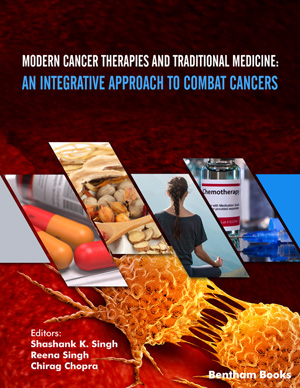摘要
背景:在全球范围内,胃癌的发病率位居恶性肿瘤的第五位,死亡率位居第三位。胃癌会导致可用于治疗的新陈代谢改变。 目的:本研究的目的是概述胃癌引起的显着代谢改变并提出阻断措施。 方法:对胃癌及其阻断引起的代谢改变的描述性和实验性出版物进行全面和最新的审查。这不是系统评价。 结果:胃癌导致糖酵解和谷氨酰胺分解的高发生率。脂肪酸从头合成和胆固醇合成的速率增加。此外,胃癌通过脂肪酸β-氧化导致脂质周转率高。临床前数据表明,通过酶靶向单独阻断这些途径会在体外和体内产生抗肿瘤作用。然而,没有关于同时阻断这五种途径的数据,这是至关重要的,因为肿瘤在响应营养物质的可用性时表现出代谢灵活性。这意味着当一种或多种被抑制时,肿瘤可能会激活替代途径。我们假设需要同时阻断它们以避免或降低可能导致治疗抵抗的代谢灵活性。 结论:有必要探索针对葡萄糖、谷氨酰胺、脂肪酸合成、胆固醇合成和脂肪酸氧化途径的联合代谢疗法的临床前疗效和可行性。这可能具有治疗意义,因为我们有针对胃癌这些途径的临床可用药物。
关键词: 胃癌、糖酵解、谷氨酰胺分解、脂质、代谢阻断、新陈代谢。
图形摘要
[http://dx.doi.org/10.3322/caac.21492] [PMID: 30207593]
[http://dx.doi.org/10.1136/gutjnl-2011-300348] [PMID: 21813476]
[http://dx.doi.org/10.1016/j.mpdhp.2014.03.010]
[http://dx.doi.org/10.1016/S1470-2045(14)71016-2] [PMID: 25638682]
[http://dx.doi.org/10.1136/gutjnl-2015-309252] [PMID: 26187502]
[http://dx.doi.org/10.1136/gutjnl-2016-312288] [PMID: 27707777]
[http://dx.doi.org/10.1016/j.bpg.2014.09.005] [PMID: 25439074]
[http://dx.doi.org/10.1016/j.bpg.2014.09.008] [PMID: 25439062]
[http://dx.doi.org/10.1097/CEJ.0000000000000580] [PMID: 32740165]
[http://dx.doi.org/10.1016/S1470-2045(10)70070-X] [PMID: 20409751]
[http://dx.doi.org/10.7150/jca.30456] [PMID: 31289579]
[http://dx.doi.org/10.1056/NEJMoa055531] [PMID: 16822992]
[http://dx.doi.org/10.1016/S0140-6736(18)32557-1] [PMID: 30982686]
[http://dx.doi.org/10.1056/NEJMoa010187] [PMID: 11547741]
[PMID: 28850174]
[http://dx.doi.org/10.1016/S0140-6736(13)61719-5] [PMID: 24094768]
[http://dx.doi.org/10.1016/S1470-2045(14)70420-6] [PMID: 25240821]
[http://dx.doi.org/10.1016/S0140-6736(10)61121-X] [PMID: 20728210]
[http://dx.doi.org/10.1016/S1470-2045(16)00175-3] [PMID: 27157491]
[http://dx.doi.org/10.1016/S0140-6736(17)31827-5] [PMID: 28993052]
[http://dx.doi.org/10.1016/j.cell.2011.02.013] [PMID: 21376230]
[http://dx.doi.org/10.3390/cancers12102819] [PMID: 33008042]
[http://dx.doi.org/10.1016/j.isci.2020.101761] [PMID: 33251492]
[http://dx.doi.org/10.3389/fonc.2019.01143] [PMID: 31737570]
[http://dx.doi.org/10.3390/metabo10070285] [PMID: 32664469]
[http://dx.doi.org/10.1007/s10120-015-0577-x] [PMID: 26643879]
[http://dx.doi.org/10.1016/S0304-3835(99)00054-3] [PMID: 10403543]
[PMID: 25932183]
[PMID: 10522065]
[http://dx.doi.org/10.1517/14728222.2013.833607] [PMID: 23984984]
[http://dx.doi.org/10.1038/sj.onc.1209603] [PMID: 16892090]
[PMID: 17352240]
[http://dx.doi.org/10.1007/s13277-010-0109-6] [PMID: 20845004]
[http://dx.doi.org/10.1371/journal.pone.0166230] [PMID: 27824926]
[http://dx.doi.org/10.1016/j.tem.2018.05.003] [PMID: 29907340]
[http://dx.doi.org/10.1038/s41419-019-1968-4] [PMID: 31558701]
[http://dx.doi.org/10.1111/jcmm.13732] [PMID: 29992789]
[http://dx.doi.org/10.3389/fcell.2019.00061] [PMID: 31106201]
[http://dx.doi.org/10.1016/j.ygeno.2004.08.010] [PMID: 15533718]
[http://dx.doi.org/10.1002/jcb.29179] [PMID: 31218757]
[PMID: 25784992]
[http://dx.doi.org/10.18632/oncotarget.17868] [PMID: 28548950]
[http://dx.doi.org/10.1016/j.semcdb.2015.08.004] [PMID: 26277545]
[http://dx.doi.org/10.3748/wjg.v18.i30.4037] [PMID: 22912555]
[http://dx.doi.org/10.1016/j.bbrc.2012.05.063] [PMID: 22627140]
[http://dx.doi.org/10.1111/cas.13211] [PMID: 28235245]
[http://dx.doi.org/10.1186/s11658-020-00228-7] [PMID: 32528540]
[http://dx.doi.org/10.1245/s10434-008-9955-5] [PMID: 18521687]
[http://dx.doi.org/10.1371/journal.pone.0091068] [PMID: 24608789]
[http://dx.doi.org/10.1002/bies.202000169] [PMID: 33165972]
[http://dx.doi.org/10.1007/s00204-020-02838-8] [PMID: 32681190]
[http://dx.doi.org/10.1038/s12276-020-00504-8] [PMID: 32943735]
[http://dx.doi.org/10.3389/fonc.2017.00306] [PMID: 29376023]
[http://dx.doi.org/10.1016/j.cmet.2019.11.020] [PMID: 31866442]
[http://dx.doi.org/10.1016/j.molmed.2019.11.004] [PMID: 31866300]
[http://dx.doi.org/10.1186/1471-230X-14-70] [PMID: 24712400]
[http://dx.doi.org/10.18632/oncotarget.19479] [PMID: 29100325]
[http://dx.doi.org/10.1007/s00432-018-2605-9] [PMID: 29435734]
[http://dx.doi.org/10.1016/j.ccr.2010.08.009] [PMID: 20832749]
[http://dx.doi.org/10.1016/j.ebiom.2018.11.063] [PMID: 30555042]
[http://dx.doi.org/10.1016/j.celrep.2019.08.076] [PMID: 31577957]
[http://dx.doi.org/10.1111/cas.13421] [PMID: 29032577]
[http://dx.doi.org/10.1002/prca.201800038] [PMID: 30485682]
[http://dx.doi.org/10.3233/CBM-190022] [PMID: 31322543]
[http://dx.doi.org/10.1158/0008-5472.CAN-08-4806] [PMID: 19458066]
[http://dx.doi.org/10.1186/s12885-016-2356-4] [PMID: 27356757]
[http://dx.doi.org/10.1186/s40170-020-00237-2] [PMID: 33413672]
[http://dx.doi.org/10.1158/1541-7786.MCR-18-0347] [PMID: 30647103]
[PMID: 26221340]
[http://dx.doi.org/10.3389/fphar.2020.01112] [PMID: 32848739]
[http://dx.doi.org/10.1096/fasebj.3.11.2570725] [PMID: 2570725]
[http://dx.doi.org/10.1007/s12032-014-0015-7] [PMID: 24924473]
[http://dx.doi.org/10.3892/etm.2012.727] [PMID: 23226763]
[http://dx.doi.org/10.3892/mmr.2016.4902] [PMID: 26936091]
[http://dx.doi.org/10.7314/APJCP.2015.16.16.6851] [PMID: 26514456]
[http://dx.doi.org/10.3892/ol.2018.8648] [PMID: 29928446]
[http://dx.doi.org/10.2217/bmm-2019-0476] [PMID: 31904263]
[http://dx.doi.org/10.1016/j.bbcan.2020.188351] [PMID: 32007596]
[http://dx.doi.org/10.3892/ol.2020.12183] [PMID: 33093924]
[http://dx.doi.org/10.1080/14756366.2020.1748025] [PMID: 32308048]
[http://dx.doi.org/10.3390/cancers11070948] [PMID: 31284458]
[http://dx.doi.org/10.18632/aging.103598] [PMID: 32726752]
[http://dx.doi.org/10.3390/cells9122600] [PMID: 33291682]
[http://dx.doi.org/10.21037/jgo-20-157] [PMID: 32953153]
[http://dx.doi.org/10.1016/j.canlet.2019.12.036] [PMID: 31904482]
[http://dx.doi.org/10.1113/expphysiol.1985.sp002935] [PMID: 3909197]
[PMID: 364152]
[http://dx.doi.org/10.1111/jnc.13630] [PMID: 27166428]
[http://dx.doi.org/10.1073/pnas.88.13.5829] [PMID: 2062861]
[http://dx.doi.org/10.1038/261702a0] [PMID: 934318]
[http://dx.doi.org/10.1152/ajpendo.00052.2013] [PMID: 23880316]
[http://dx.doi.org/10.1016/j.ydbio.2017.12.001] [PMID: 29224892]
[http://dx.doi.org/10.1016/0020-711X(88)90303-5] [PMID: 8138012]
[http://dx.doi.org/10.1016/j.lungcan.2018.10.016] [PMID: 30527190]
[http://dx.doi.org/10.18632/oncotarget.18854] [PMID: 28969010]
[http://dx.doi.org/10.1158/1535-7163.MCT-14-0183] [PMID: 25122071]
[http://dx.doi.org/10.1007/s11307-014-0814-4] [PMID: 25561013]
[http://dx.doi.org/10.1016/j.cellsig.2014.07.024] [PMID: 25041845]
[http://dx.doi.org/10.1007/s13402-020-00575-9] [PMID: 33464483]
[http://dx.doi.org/10.1007/s11307-012-0587-6] [PMID: 22886728]
[http://dx.doi.org/10.1155/2015/690492] [PMID: 26425550]
[http://dx.doi.org/10.3892/or.2015.4077] [PMID: 26134042]
[http://dx.doi.org/10.1158/0008-5472.CAN-03-3645] [PMID: 15026345]
[http://dx.doi.org/10.3892/ol.2017.5615] [PMID: 28454342]
[http://dx.doi.org/10.3892/ol.2020.11838] [PMID: 32782623]
[http://dx.doi.org/10.1038/s41598-021-84538-6] [PMID: 33664364]
[http://dx.doi.org/10.1002/cmdc.201200176] [PMID: 22684868]
[http://dx.doi.org/10.1016/j.cbpa.2021.01.006] [PMID: 33721588]
[http://dx.doi.org/10.3390/molecules25173935] [PMID: 32872164]
[http://dx.doi.org/10.1016/j.canlet.2018.08.006] [PMID: 30102953]
[http://dx.doi.org/10.3389/fonc.2021.682911] [PMID: 34109128]
























